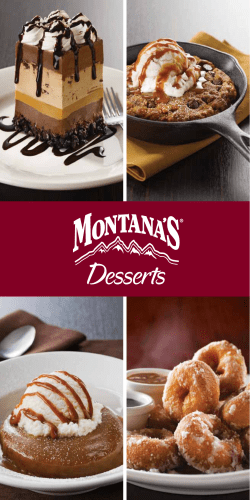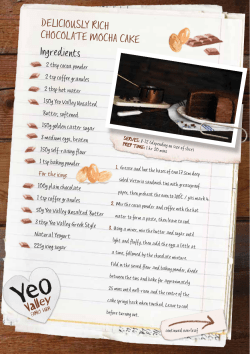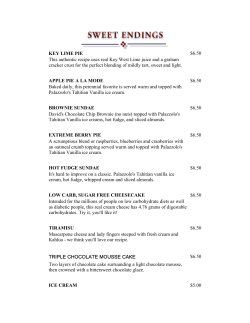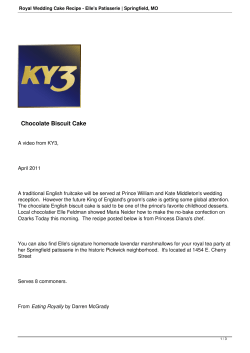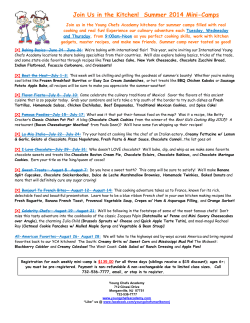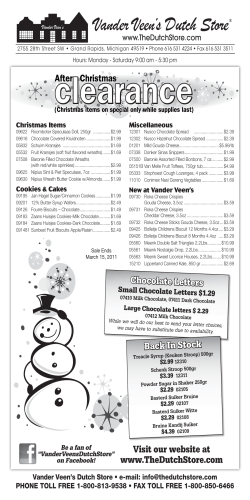
Finest Fondant Powder application guide
Finest Fondant Powder application guide - - CONTENTS ♦ Snowline®, fine and stable fondant powder ♦ Snowline® in icings ♦ Icing basic recipe ♦ Mocha icings ♦ Chocolate icings ♦ Icing of frozen products ♦ Icing of wrapped products ♦ Snowline® in fillings ♦ Waffles ♦ Pralines ♦ Chocolate fillings ♦ Snowline® in fudges and chewy candies ♦ Snowline® in marzipan - - Snowline® is a very fine and stable fondant powder. It is the ideal ingredient for high quality icings and smooth fillings. High quality EC n°1 beet sugar and non-GMO glucose syrup are the basic ingredients of our Snowline®, which combines all the qualities of a traditional paste fondant with the inherent advantages of a fine powder. ♦ very fine microcrystals ♦ stable even after a long storage ♦ optimal texture and gloss of the end product ♦ flexibility of rehydration and control of the water content ♦ easy to use, easy to mix Fondant powder Snowline® can be used in a wide variety of applications in the bakery, biscuits and confectionery sectors. - - Snowline® is available in two standard formulations: Snowline® S11 contains 11% glucose syrup and 89 % sucrose. S11 is mostly used in icings but also in fat fillings, fudges and chewy candies. Snowline® S17 contains 17% glucose syrup and 83 % sucrose. S17 is used in fat fillings as well as in waterbased fillings. Its high gloss makes it the ideal fondant for the icing of fresh pastries. In addition to our two standard formulations we also propose in our range: ♦ The Freeze - thaw stable Snowline SDG, for the icing of frozen pastries. ♦ The Wrapable Snowline SWI, which is the perfect ingredient for the icing of wrapped products. ♦ The Ultrafine icing sugar Snowline SFO ♦ Tailor- made formulations to meet specific customers demands - - Snowline® in traditional icings Icing is certainly the most common application of Snowline for the decoration of cakes and pastries. Both standard formulations are convenient to enter in an icing recipe. The amount of water added and the type of Snowline are adaptable to the water activity of your product for a better result. S17 will be preferred for icing of fresh products to be sold rapidly, and also for a smooth and shiny result. With a shorter drying time and reduced stickiness, S11 is more appreciated in industrial bakeries. Snowline® is very easy to use in this application. The cream obtained is easy to handle thanks to a good viscosity at the icing temperature and Snowline® will provide your final product with a perfect glossy finish. - - Snowline® basic icing recipe Below recipe is shown as a basis and will give the baker a perfect result for products to be sold shortly after manufacturing. For a longer shelflife, the formulation and type of Snowline can be adapted considering the support to be iced. Many variations of this basic recipe are possible using colours and flavours, giving rise to an infinite variety of icings, the key being the baker’s creativity. Basic formulation: ß 1000 g ß 130 g Snowline water Process: ß ß ß ß ß Add water to Snowline® Add colours and flavours at your convenience Mix it well Temper round 30-35°C Ice Given temperatures are standard temperatures. They may be raised for a better viscosity without any deterioration in the quality of the product. Should the icing become too liquid, just allow it to cool down for a few minutes. - - Snowline® in Mocha Icings Snowline® is of perfect use for all sorts of icings. The recipe for mocha icing given below is typically one of the many variations in icings that can be obtained by using Snowline. Mocha icing recipe Basic formulation : ß ß ß ß 1000 g Snowline 130 g water 12 g mocha flavour 1 goutteyellow colour Process : ß ß ß ß Add water, flavour and colour to Snowline® Mix it well Temper round 30-35°C Ice The temperatures given are standard temperatures. They may be raised for a better viscosity without any deterioration in the quality of the product. Should the icing become too liquid, just allow it to cool down for a few minutes. Flavour and colour can also be added to the paste at 35°C. Should you not have mocha flavour, you can directly replace the water by strong black coffee. More sophisticated results can be obtained by sprinkling the iced product with fine chopped almonds and small size pearl sugar. - - Snowline® in Chocolate Icings The following chocolate icing recipe offers an alternative to the traditional pure chocolate icing. By introducing Snowline® in the recipe, the taste and final aspect will be preserved at a lower cost. Chocolate icing recipe Basic formulation : ß 1000 g ß 150 g ß 200 g Snowline water fondant chocolate Process : ß ß ß ß ß Melt the chocolate at 45°C Add Snowline and water to the melted chocolate Mix it well Warm it up at 40-45°C Ice - - Icings of Frozen Pastries For the icing of frozen pastries, we recommend to use our new special freeze-thaw stable Snowline® SDG. This freeze-thaw stable fondant powder has been especially developed for the icing of frozen pastries or desserts. ü ü ü ü The icing does not crack The icing does not run down the pastry The moisture migration is reduced The icing is white and glossy Applications: ü Donuts ü Berliners ü Cream cakes ü French and Danish pastries… Formulation de base: ß 1000 g ß 134 g Snowline® SDG eau Process : ß ß ß ß Add water to Snowline® SDG Mix it well Heat at 45-50°C Ice To keep a better shininess, don’t heat at more than 55°C. - 10 - Icings of Wrapped Products Looking for a stable close-wrapped icing ? Use our powder fondant Snowline® SWI. Here are the main advantages of this new ingredient: ü ü ü ü Does not stick to plastic film Smooth and sweet taste Long shelf-life Reduced moisture migration Applications: ü ü ü ü ü iced fingers Belgian buns Swiss buns Danish pastries cup cakes… Formulation de base: ß 1000 g ß 115 g Snowline® SWI water Process: ß ß ß ß Add water to Snowline® SWI Mix it well Heat at 60°C and go on with an efficient mixing Ice and wrap If required adjust the viscosity by adding more water or more Snowline®. - 11 - Snowline® in fillings Fondant powder Snowline® is particularly valuable in combination with fat for a wide variety of fillings. It is appreciated as it gives enhanced smoothness to the final product. Its incorporation is easy. No need to rehydrate Snowline before use. The water contained in the other ingredients will indeed play this role, allowing a reduction of water activity and extended shelf-life. Basically used for filling small waffles, the recipe given below could also be used as filling for biscuits, wafers and all sorts of filled products. In an automated process, the cream is easy to extrude and its viscosity can be easily regulated by the control of the water content. Waffle filling recipe Basic formulation: ß ß ß ß ß ß ß 1000 g 300 g 60 g 10 g 20 g Snowline S17 vegetable fat water citric acid kirsch or other alcohol emulsifier (facultative) flavours (at convenience) Process: ß Work the vegetable fat with citric acid and flavours (if needed) ß Add Snowline and water and mix for about 15 minutes ß Incorporate the alcohol by mixing it 1 – 2 minutes with the other ingredients For a more aerated result, the vegetable fat must be cold and the use of an emulsifier is recommended. A higher content of water will give rise to a light cream; with less water, the cream will be firmer and shorter. Large variations are possible using vanilla flavour, honey, fruit extracts, … adding frappe or brown sugar. - 12 - Snowline® in Pralines and Chocolate fillings Snowline is suitable for use in ß Cast creams on basic recipes containing only sugars (coloured - flavoured), sugars with fats, sugars with alcohol ß Hard chocolate centres to be coated ß Ganache creams, truffles and their many variations Snowline can be mixed with most fats: from dairy cream to vegetable fats. Specific benefits Easy of use, Snowline® can be added at any stage of the process: ß no need to rehydrate : the water contained in the other ingredients is sufficient ß no need to temper ß easy to dose Adding Snowline®, you won’t add any water ß better control on Aw ß more flexibility ß more space for creativity The finest microcrystals ensuring an optimal texture ß for a perfect mouthfeel Suggested recipes Some traditional pralines and chocolate fillings recipes are given in the following pages. Of course, these are only examples, mostly based on famous products: ♦ Gianduja ♦ Manon ♦ Truffles ♦ Fruit cream ♦ Hard fondant cream ♦ Creamy cherry centre - 13 - Snowline® in Gianduja Gianduja is certainly one of the most famous Belgian pralines. The delicious taste of hazelnut and chocolate is enhanced by a perfect mouthfeel. In this recipe, the praline slowly melts on the tongue in a refined texture that is assured by the very fine crystals of Snowline®. The recipe is given on basis of vegetable fat; butter will be preferred for a more luxury result. Gianduja Recipe Basic formulation : ß ß ß ß 1000 g 1000 g 1000 g 1000 g Snowline hazelnut paste couverture chocolate vegetable fat Process : ß Melt the chocolate at 45°C (or better, temper it) ß Add the hazelnut paste, vegetable fat and Snowline ß Mix it well for a few minutes This cream may be injected in small chocolate cups, shaped in a more sophisticated cone or directly rolled out and cut in small cubes to be wrapped. - 14 - Snowline® in Manon The success of the Manon praline comes from the subtle combination of the coffee flavour of the interior cream and the white chocolate. A variation of this praline is often obtained by simply constructing it around a shelled walnut. The use of Snowline is here particularly interesting for a better control of the content in water. It can compensate a part of the water brought by the dairy cream for a longer shelf-life. Manon recipe Formulation de base : ß ß ß ß ß 2000 g 1000 g 400 g 1000 g 50 g Snowline white chocolate dairy cream vegetable fat mocha flavour Process : ß ß ß ß Melt the white chocolate (or better, temper it) Whip it with Snowline® and flavour Incorporate the cream Incorporate the vegetable fat and beat for a few minutes This cream is a filling for white chocolate pralines. These can be obtained for example by the following method: - - - put the cream in a white chocolate shell allow it to cool down in the fridge cover the base of the praline with white chocolate. Many variations are possible on this basic recipe, the most common being to put up the cream around a shelled walnut. - 15 - Snowline® in Truffles Originally exclusively used to design the fleshy fungus so famous in the French gastronomy, the term “truffle” has long been used to designate a praline made of butter and chocolate, shaped in the form of the famous underground delicacy. The term is now used for a very wide variety of products made on these basics. The butter is replaced by vegetable fat or dairy cream, the chocolate can be merely cocoa. The relative part of each ingredient is not defined, neither is that of sugar, what can also lead to white truffles. Alcohol is often added. Truffles recipe with dairy cream Basic formulation : ß ß ß ß ß 1000 g 200 g 80 g 2 g 20 ml Process : A truffle paste will be obtained by merely mixing together the above ingredients. The addition of rum is facultative. Variations may be obtained by replacing cocoa by melted chocolate, increasing the proportion of dairy cream, using butter to achieve different qualities of truffles to be cut or extruded. 6 - Snowline® in Truffles The following basic applications aim at being representative of what can easily be done on the basis of a simple truffle or fat filling recipe. By merely changing one parameter or the way of enrobing the filling, 4 different pralines will be obtained. Here again, the choice of the basic ingredients could be different, using for example fondant chocolate in place of white chocolate would give rise to a totally different result. Basic recipe Basic formulation : ß ß ß ß 400 g 500 g 300 g Snowline butter white chocolate (tempered) Vanilla flavour Process : ß ß ß ß ß ß Work the butter in order to soften it. Add Snowline and whip to obtain an homogeneous mass Incorporate the tempered white chocolate Put up the cream as to form small fingers or bowls Put it in the fridge for one hour Enrobe and roll at convenience - 17 - To realise these “snowballs”, the above preparation was enrobed with white chocolate and then rolled in Snowline® S11. These almonds truffles are obtained by rolling the above preparation first in a cappuccino chocolate and then in roasted almonds For these pralines, the basic preparation was enriched by 50 g of hazelnut paste. It is here a filling for caramel chocolate shells. These more traditional truffles were coated with fondant chocolate and then rolled in a mix containing 2/3 of cocoa and 1/3 of icing sugar. - 18 - Snowline® in Fruit cream This recipe of fruit cream is an example of cream to be cast, the particularity coming from the addition of fat. Most recipes are using fruit aromas or fruit concentrates. The use of Snowline® allows the use of fruit ingredients containing more water such as fruit syrup in the following recipe. Fruit cream recipe Basic formulation : ß ß ß ß ß 1000 g 300 g 80 g 40 g 5 ml Snowline fruit syrup (blackcurrant for example) vegetable fat frappe citric acid Process : ß Mix Snowline and fruit syrup ß Add the vegetable fat (easier at ambient temperature) ß Mix it well ß Add frappe and citric acid ß Mix well - 19 - Snowline® in hard fondant cream Hard fondant cream is certainly one of the oldest confectionery products using fondant. Basically, it was exclusively made of flavoured fondant. It is also the basic formulation of the famous mint “after-eight”. The following recipe gives an alternative using bob syrup for a cheaper formulation. Hard fondant cream recipe Basic formulation : ß ß ß ß ß ß 600 g 1200 g 180 g 250 g 40 ml 4 ml Snowline sugar glucose syrup water citric acid lemon aroma Process : ß ß ß ß ß ß ß ß Cook sugar, glucose syrup and water at 114°C Remove it from the heater and cool it down in a mixer round 90°C Add Snowline® and mix well Add citric acid and aroma Mix for 1 minute Cast in rubber moulds round 75 - 80°C. Get out off the moulds after 15 to 30 minutes The centres are then coated with chocolate Other aromas can be used : vanilla, orange, mint, strawberry,… - 20 - Snowline® in creamy cherry centre The following recipe is a variation of the famous “cerisette“ praline. The centre obtained is perfectly white and creamy. In the course of time, it will evolve in a more liquid product due to the alcohol present in the cherry. Cream and chocolate offer a pleasant smooth combination for a highly refined praline. Cherry cream recipe Basic formulation : ß ß ß ß ß ß 1000 g 125 g 30 g 145 g Snowline water glucose syrup invert sugar cherry in alcohol tempered chocolate Process : ß Form the chocolate shells and allow them to cool down ß Place a cherry in each chocolate shell ß Mix Snowline® together with water, glucose syrup and invert sugar and warm it up to 32 – 35 °C (temperature to be neutral on the lips) ß Fill the shells with the cream ß Allow it to cool down for a few minutes ß Close the shells with tempered chocolate To prevent the cherry from coming up at the surface of the cream and deforming the covering chocolate layer, the shells should be moulded in two stages. A first chocolate layer is formed and allowed to dry completely. On the top of this first layer, a second chocolate layer is applied. When placing the cherry in the shell, this second layer shouldn’t be completely dry so that the cherry sticks in the melted chocolate and stays in the bottom of the shell when filling it up with the cream. For the cream to become completely liquid after a short period, invertase should be used in a proportion round 0.12% of the total recipe. Aroma can be useful depending on the quality of the cherries. - 21 - Snowline® in Fudge The fudge application given below is a typical example of what can be done by using Snowline® as a graining agent. The same principle is used in the confection of chewy candies and in the hard fondant cream to be coated with chocolate. A wide variety of products can be obtained on this basis. The factors of influence to be changed to obtain different textures and properties in the final product are the composition and proportion of bob syrup and the processing temperatures. Fudge Recipe Basic formulation : ß ß ß ß ß ß ß ß ß 330 g 150 g 250 g 50 g 800 g 330 g 1000 g sugar brown sugar glucose syrup invert sugar sweet condensed milk butter (or vegetable fat) Snowline S11 salt flavour Process : ß Prepare a syrup by cooking sugars, glucose syrup, invert sugar and milk up to 105°C ß Add fat and allow it to boil at 117°C ß Stop cooking and add salt, then Snowline and flavours ß Mix it well ß Roll it out and cut in small cubes Butter is more used in “hand-made” fudge, replacing it by vegetable fat may result in a change in taste that can be corrected by using adequate flavours. - 22 - Snowline® in Marzipan This delicious speciality is made of almonds and sugar. The use of Snowline® in the preparation gives the opportunity to process on the basis of a simplified recipe without loss of smoothness or fineness in the final product. The quality of Marzipan is determined by the percentage of almonds in the preparation. The simplified recipe described hereunder gives rise to a basic 33% marzipan. A richer recipe is obtained on a 50% basis using equal amounts of Snowline® and almonds. Marzipan Recipe Formulation de base : ß ß ß ß 1000 g 500 g ≥ 50 g 1.5 g Snowline S17 ground almonds water almond extract Process : For a good result the almonds must be very finely ground. The first step consists in finely milling ground almonds and Snowline®. To avoid warming up during this operation, the almonds should be kept refrigerated before use. Then, add water and almond extract and mix all ingredients together. This second step can be manually realised by kneading it all on the counter. The percentage of water to be added depends on the desired final texture. A minimum of 50 g (5% of the Snowline® weight is recommended) but it can be raised up to 100 g. Adding too much water should be avoided as it will have a negative effect on the shelf-life of the product. The paste obtained can either be rolled to decorate a cake, or cut in small cubes or any other forms that can also be covered with chocolate. More sophisticated products can easily be obtained by adding colours to the basic recipes and modelling all sorts of small subjects: animals, fruits,… - 23 - For more details, do not hesitate to contact our Sales Department. Sucrerie Couplet s.a. Rue de la Sucrerie 30 7620 Brunehaut-Wez Belgique Phone : 0032 / (0)69.34.36.50 Fax : 0032 / (0)69.34.36.60 E-mail : [email protected] www.coupletsugars.com
© Copyright 2025
